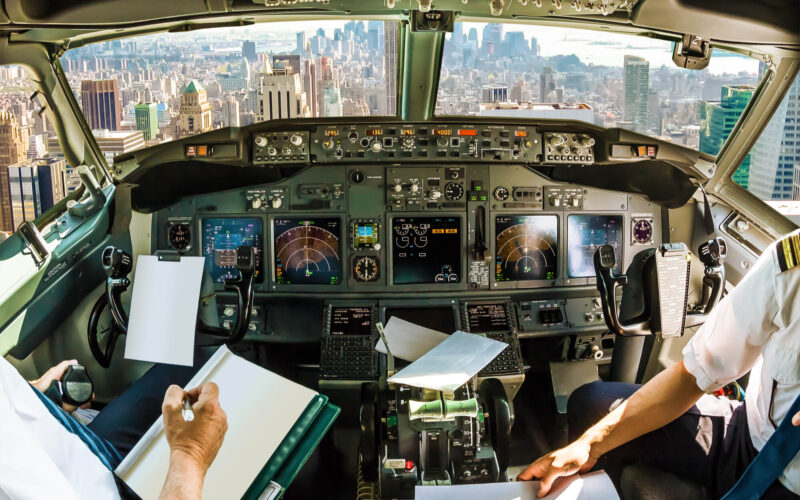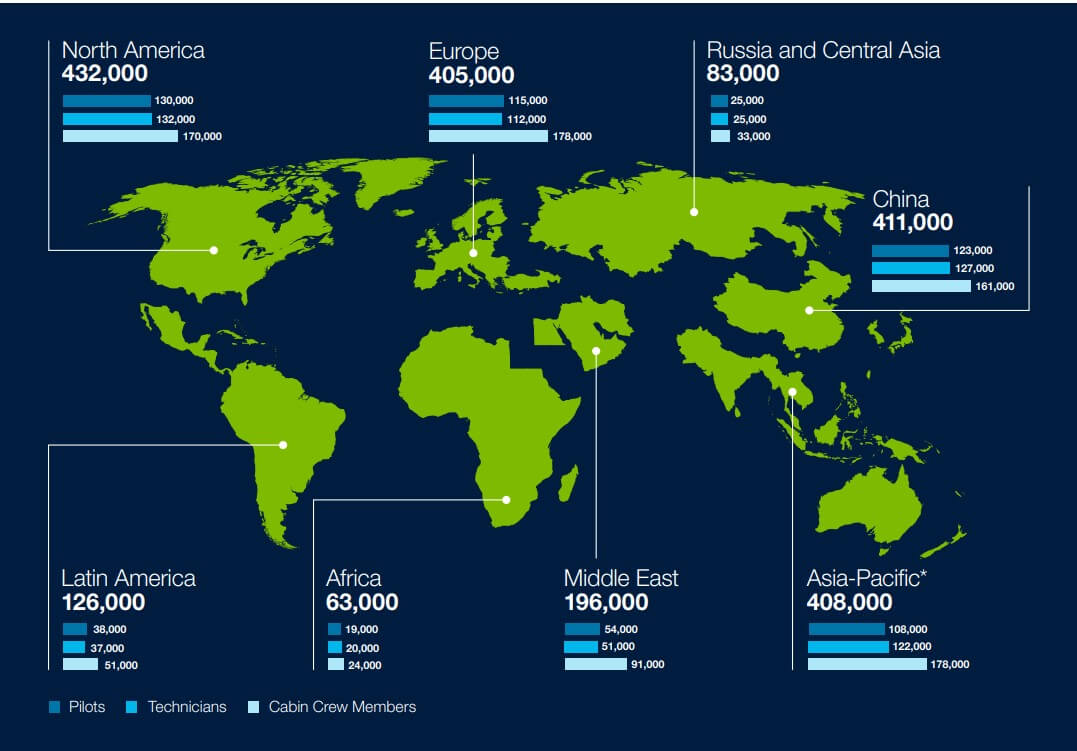A shortage of pilots in the US has led to airlines cutting schedules and having to boost pay and bonuses to staff their operations. AeroTime investigates what led to the current situation.
The pilot shortage in the United States started making itself felt in the second half of 2021 as carriers ramped up operations to take advantage of returning travel demand after the COVID-19 pandemic.
The International Air Transport Association (IATA) expects the North America region to recover more quickly than other regions of the world. It forecast on March 1, 2022 that passenger numbers will reach 94% of 2019 levels in 2022, with full recovery expected in 2023.
“After a resilient 2021, traffic to/from/within North America will continue to perform strongly in 2022 as the US domestic market returns to pre-crisis trends, and with ongoing improvements in international travel,” IATA predicted.
However, while people want to travel, airlines in North America are struggling to keep pace. Bad weather and staffing shortages led to thousands of flight cancellations over the busy Christmas period and major carriers have announced cuts to flight schedules for this year.
A real battle is now on to hire pilots, with airlines announcing more incentives and higher pay to tempt employees, while others are announcing partnerships with flight schools or even operating their own schools.
Did being a pilot lose its glamour?
The roots of the current situation lie as far as back as 9/11, explained Maximilian Buerger, managing director of AFM.Aero, a market intelligence platform and advisory firm for the pilot training industry.
The US travel industry slumped after the 9/11 attacks on the World Trade Center in New York in 2001. Then came the global financial crisis just a few years later, in 2007/2008. Many airlines nearly collapsed and consolidation followed. That led to major cost cuts, including to pilot salaries, with first officer pay sometimes being at minimum wage levels.
Finally, the Colgan Air crash of 2009 led to a requirement that pilots must accrue 1,500 hours before they can fly for the commercial carriers in the United States.
All of those factors combined to reduce the lure of the job, Buerger said.
“The pilot profession is just not seen to be as attractive in the US as it is in other regions.,” Buerger said. “You have to spend a lot of money on training, you start on a lower salary than in other sectors such as banking or IT, and then you can’t even get to the airlines for two years because you have to build your hours.”
Buerger added the pandemic has damaged the image of being a pilot further. “There’s instability, what if there is another wave? You might lose your job again.”
Added to those factors, the pandemic has meant that airlines have used early retirements as a way to cut costs quickly during the downturn, while schools have halted training programs, leaving a gap at entry-level .
United Airlines chief executive Scott Kirby commented in a blog published on January 27, 2022 that he doesn’t believe the pilot shortage is a function of pay, but rather the time and expense involved in training.
“At United, we’re convinced that the root of the problem is that it costs over $100,000 and takes five or more years to obtain all the training to become eligible to fly for a major airline,” Kirby wrote. “A commercial pilot’s journey is technically complex, building hours and obtaining certificates in a process that is difficult to navigate without experienced support.”
What actions are US airlines taking?
The current shortage of pilots is being felt most keenly at the regional carriers. Pilots usually begin their careers at the regional airlines and then move on to the more prestigious mainline carriers.
While regional carriers usually plan for this movement, the early retirements at major carriers during the pandemic, plus the faster than expected recovery, means that airlines like Skywest are losing their captains to the majors much more quickly than expected.
“So while our pipeline for new pilots is strong, we expect that upgrade timing creates an imbalance and production constraint for the next year or so,” SkyWest (SKYW) chief executive Chip Childs said on a fourth-quarter results call on February 3, 2022.
SkyWest (SKYW) has therefore reduced schedules and implemented upgrade and retention incentives to attract and retain staff. The scheduling challenges and increased labor costs will also constrain its ability to make profit this year.
“In summary, 2022 looks to be the next phase of our COVID recovery and while demand for our product has never been stronger, the current staffing imbalance and ongoing refleeting doesn’t allow us to monetize that demand in the short-term,” Childs added.
Low cost carriers Avelo and Breeze are raising pay, as is Delta Airlines (DAL). Regional carrier Endeavor is offering all pilots a $110,000 retention bonus if they stay for a certain time, while new-hire bonuses will temporarily increase from $20,000 to $40,000.
Breeze also has a different solution. It is accepting pilots from Australia, under the E3 visa scheme between the United States and Australia.
Meanwhile, United Airlines boasts that it is the only major US airline to own and operate its own flight school. It opened the doors to its Aviate Academy in Goodyear, Arizona in February 2022. CEO Kirby estimates United will hire 10,000 new pilots by 2030. The airline has a goal to train about 5,000 new pilots at the school by 2030, with at least half being women or people of color. United also teamed up with JP Morgan to offer $2.4 million in scholarships in 2021.
Alaska Airlines and regional partner Horizon Air said on March 9, 2022 that they were teaming up with Hillsboro Aero Academy to launch the Ascend Pilot Academy development program for aspiring pilots.
The two airlines said they plan to register and train up to 250 students a year and that the cadet pilots will be eligible for financial aid, a $25,000 stipend and a conditional job offer at Horizon, with the prospect to join Alaska later.
“The program is part of a larger effort to address a growing pilot shortage coupled with increased travel demand,” the airlines said in a press release.
Will the pilot shortage be repeated elsewhere?
Boeing highlighted in its 2021-2040 Pilot and Technician outlook that the recovery across the world will be uneven with pilot shortages in some regions. It downgraded the number of pilots needing to be hired over the next 20 years to 612,000 worldwide from a previous prediction of 763,000 made in 2020.
Credit: Boeing
Of the 612,000 pilot hires, North America accounts for the biggest chunk at 130,000. Boeing said the pandemic has led to pilot training programs being suspended, junior pilots losing their jobs and more experienced pilots taking early retirement. It said operators will need to plan ahead to make sure they have enough pilots to fly their routes.
“With the dual impact of a smaller qualified pilot pool and accelerated retirements, it is expected that regional pilot shortages and strong competition for qualified pilots will re-emerge within the next few years,” Boeing predicted.
AFM.Aero’s Buerger says globally we could end up in a situation similar to 2018/2019, when airlines hungry for pilots were snapping up flight instructors from flight schools, leaving the schools unable to train enough new pilots to meet demand. Airlines will most likely also start stepping in to finance cadet programs after a long gap.
“I predict that 2023 will be the year of the cadet program. As long as airlines can offer a job at the end of training, schools can use that to set up financing programs.”
“This industry follows quite a pronounced boom and bust cycle,” concludes Buerger. “We just had the biggest bust in the history of this industry and the effects of it could lead to the biggest boom the pilot training industry has ever experienced.”


